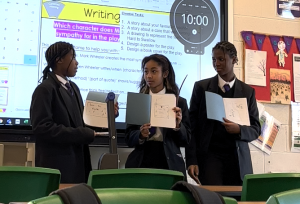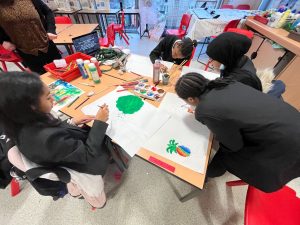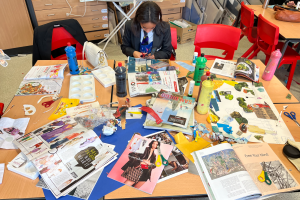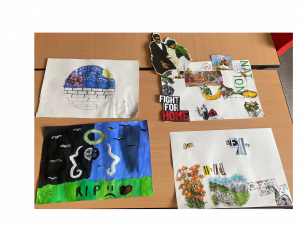Goldsmiths’ student (Fine Arts 2021-22) Cherelle Angeline writes:
I was starting my foundation year of Fine Arts at Goldsmiths when I received an exciting newsletter announcing the SHAPE Park Life Project, and I thought of being involved in engaging with local issues outside of my studies. I was immediately interested because it bridges my interest of education in raising the awareness of environmental and social sustainability through creative engagement, where I can connect with my local community to talk about important issues around us, bridging the social gap between university and junior school students. It is difficult to get into schools and work with them, but our group leader, Dr Francis Gilbert, had strong links with Deptford Green, where he supervises PGCE students for his PGCE course, and he put us in touch with a Secondary teacher at the school.

Picture 1 The video team experimenting with the devices (iPad and 360 camera) for the first time
We started with a goal to develop innovative creative research methodologies with young people to raise voices about local environmental and social issues. Our research questions that we are exploring are: How do students at Deptford Green School engage with their local park (Fordham Park)? How would students/teachers/parents like to improve Fordham Park?
On the initial stage of the project at Deptford Green, our decision to recruit secondary students from the school as co-researchers led us to be invited to school to host creative workshops with 12 students (ages 11-15) running over 7 weeks.
We have undertaken survey by collecting discarded trash on the corners, recording the point of view of animals underneath the trunks, overlooking the piled trash. In this process, conversations were built with the students as co-researchers, giving them space to explore their voice and creativity through direct research in the park.
We carried the wooden sticks from the park back to the school, then we drew our ideas for construction of the wooden sticks into sign “Save the Planet”. It was very alarming and ambitious in which throughout the project, we disseminate the big concept of sustainability by implementing it in the lives of the children which begins to appear actionable and closer to reach for all of us. We started discovering sustainability in daily life and how it can be learnt and talked about between peers.

Picture 2: Initial presentation of the visual arts team

Picture 3: Visual arts station doing painting

Picture 4: Visual arts station doing collaging activity

Picture 5: Paining and collage
Towards the mid-point of our workshop sessions, we have initially planned to respond to the poem the other group wrote. However, Katherine, insisted that she wanted to paint something that is not about the park. They opened up with their emotions more on this session. Katherine has painted a portrait of a non-identified person with a dark background, showing the struggle of mental health and anxiety. She opened about her experience in being self-consciousness in the park, of being seen by people and questioning. They were very honest in their personal emotions which is one of our goals. Saraiah painted a phrase “Boring in the park” with a sad face, and dull colors smashed around the paper. Reglina painted a bright orange and yellow sunset with dark hills. She drew hills continuously on the daily basis which to me sounds like her imaginary safe space and hope to dawn of the day. We were bonding through conversations and as we were painting abstractly. It has brought a realization that a less structured class affects the kids’ decision on mixing paint more loosely. They have shared about their dreams. It is a precious gift to facilitate the children’s personal development while also realising their dreams. Katherine wants to be a psychologist to talk to people about mental health and help them. Reglina wants to be an artist to paint and draw.
Through collaboration with young students, there is hope in creating a safe creative space within and outside the classroom and larger Deptford Green community for conversations about what matters to them through artistic expressions. This way, field research is more than gathering data and academic outputs, but it is about engagement and growing relationships between generations of different backgrounds that will last in the children’s minds and whole community. I hope that the children have felt that they have been listened to and given the platform to make real changes in their school community.
Looking to work in community arts and education, this experience has inspired me to use the creativity of the hands to engage with young people, echoing their joys, fears, hopes, and dreams for a better world. It has fueled my motivation and determination in creating a difference that lasts.
Resources for further reading
Jónsdóttir, Á. (2017) Artistic Actions for Sustainability: Potential of art in education for sustainability. Ph.D. degree and a Doctor of Art degree in the School of Education and Faculty of Art and Design. The University of Lapland. Available at: https://core.ac.uk/download/pdf/132157571.pdf
Desai, D. (2020) ‘Educating for Social Change Through Art: A Personal Reckoning’, A Journal of Issues and Research 2020, 61(1), 10-23. Available at: https://doi.org/10.1080/00393541.2019.1699366
Heras, M. (2021) ‘Realising potentials for arts-based sustainability science’, Sustainability Science, Vol. 16 (6), 1875-1889. Available at: https://link-springer-com.gold.idm.oclc.org/article/10.1007/s11625-021-01002-0.